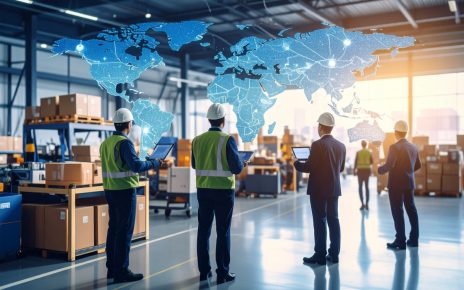The world of international trade is undergoing a rapid transformation, fueled by the integration of artificial intelligence (AI) and automation. Traditionally characterized by paperwork-heavy processes, fragmented supply chains, and human-led logistics, cross-border trade is now being reshaped by technologies that are smarter, faster, and more connected than ever before.
As businesses aim to improve efficiency, reduce costs, and navigate the complexities of global commerce, AI and automation are emerging as the key enablers of innovation and competitiveness. In 2025, companies that embrace these technologies are not just streamlining operations—they are redefining the future of global trade.
This article explores how AI and automation are revolutionizing cross-border operations, from customs clearance and predictive logistics to intelligent compliance and trade financing.
1. The Urgency for Modernization in Global Trade
Despite the growth of digital platforms, international trade has long lagged behind in terms of innovation. Many companies still rely on manual paperwork, legacy systems, and siloed data to manage shipments, payments, and compliance. This creates inefficiencies, delays, and high operating costs.
Post-pandemic supply chain shocks, labor shortages, and geopolitical tensions have made it clear: global trade must become more agile, transparent, and technology-driven. AI and automation offer precisely those capabilities—enabling businesses to operate smarter and at scale.
2. AI-Powered Supply Chain Visibility
One of the biggest pain points in cross-border trade is lack of end-to-end visibility. Goods often pass through dozens of checkpoints, jurisdictions, and partners—each with their own systems and data.
AI platforms are now enabling real-time supply chain visibility through:
Predictive analytics: Forecasting delivery delays, route bottlenecks, and inventory risks
Sensor data analysis: Tracking cargo temperature, location, and condition
Machine learning algorithms: Optimizing shipping routes and load balancing
Digital twins: Simulating global supply chain scenarios to test resilience
Companies using AI for visibility can respond to disruptions faster, reduce transit times, and make informed logistical decisions.
3. Intelligent Customs and Border Management
Customs clearance has long been a manual, paper-intensive process prone to delays and human error. But now, governments and trade organizations are digitizing borders with AI-driven systems that automate inspections, documentation, and risk assessments.
Benefits of AI in customs include:
Automated document scanning and anomaly detection
Risk profiling of shipments to flag high-risk containers
Real-time trade data validation using blockchain and AI integration
Faster clearance times through e-declarations and smart classification
For example, Singapore’s Networked Trade Platform and the EU’s Customs Data Model are leveraging AI to modernize border workflows, making it easier for businesses to move goods efficiently and compliantly.
4. Automation in Warehousing and Fulfillment
International trade involves not only the movement of goods but also storage, picking, packing, and dispatching—areas where automation is making a major impact.
Advanced technologies like:
Autonomous mobile robots (AMRs) for warehouse navigation
Robotic arms for sorting and palletizing
AI inventory systems that forecast demand and reduce stockouts
Automated order management for cross-border fulfillment
…are significantly reducing labor costs, increasing accuracy, and accelerating delivery times.
Major players like Amazon, Alibaba, and DHL are leading the way, but mid-sized exporters and logistics firms are also adopting warehouse automation to stay competitive.
5. Smart Trade Finance and Document Automation
International transactions involve complex financing, letters of credit, compliance documents, and invoicing—often spread across banks, exporters, importers, and freight providers.
AI and automation are simplifying trade finance by:
Digitizing and validating documents like bills of lading and certificates of origin
Using natural language processing (NLP) to extract data from unstructured trade paperwork
Automating KYC/AML checks for financial compliance
Offering AI credit scoring to assess borrower risk in trade loans
Startups and fintechs like Traydstream, Komgo, and Marco are disrupting traditional trade finance with intelligent platforms, reducing paperwork errors and increasing transaction speed.
6. Compliance and Regulatory Automation
One of the most complex areas in cross-border operations is staying compliant with international regulations, tariffs, and sanctions. These requirements change frequently and vary across jurisdictions.
AI tools can help businesses:
Stay updated on tariff changes, trade agreements, and customs rules
Automatically flag shipments that violate sanctions or embargoes
Validate product classifications and documentation in real time
Generate accurate country-of-origin reports and audit trails
By automating compliance workflows, companies minimize regulatory risk and avoid costly delays or penalties.
7. Enhancing Sustainability in Trade
Sustainability is increasingly a priority in global commerce, with pressure to reduce emissions, eliminate waste, and trace ethical sourcing.
AI helps by:
Optimizing transportation routes to minimize fuel use
Tracking carbon emissions per shipment
Identifying low-impact suppliers and logistics partners
Creating sustainability dashboards to report on ESG metrics
Smart trade systems not only improve performance but also help businesses meet green trade requirements in markets like the EU and North America.
8. Overcoming Challenges of AI Adoption
Despite the clear benefits, companies face hurdles in adopting AI for international trade:
Data silos: Poor integration between systems and partners
Skills gap: Lack of in-house AI or automation expertise
Cybersecurity risks: Greater digitization increases vulnerability
High initial costs: Implementing smart systems can require significant investment
To overcome these, businesses must start with small pilot projects, partner with specialized vendors, and invest in training and data governance.
Conclusion
AI and automation are no longer futuristic add-ons—they are core enablers of modern international trade. From smart warehouses and AI customs to automated compliance and predictive logistics, these technologies are revolutionizing how goods, information, and money move across borders.
For companies engaged in cross-border commerce, embracing AI means more than operational efficiency—it means gaining agility, visibility, and resilience in an unpredictable global marketplace.
The winners in tomorrow’s trade landscape will be those who use technology not just to keep up, but to lead the transformation.



